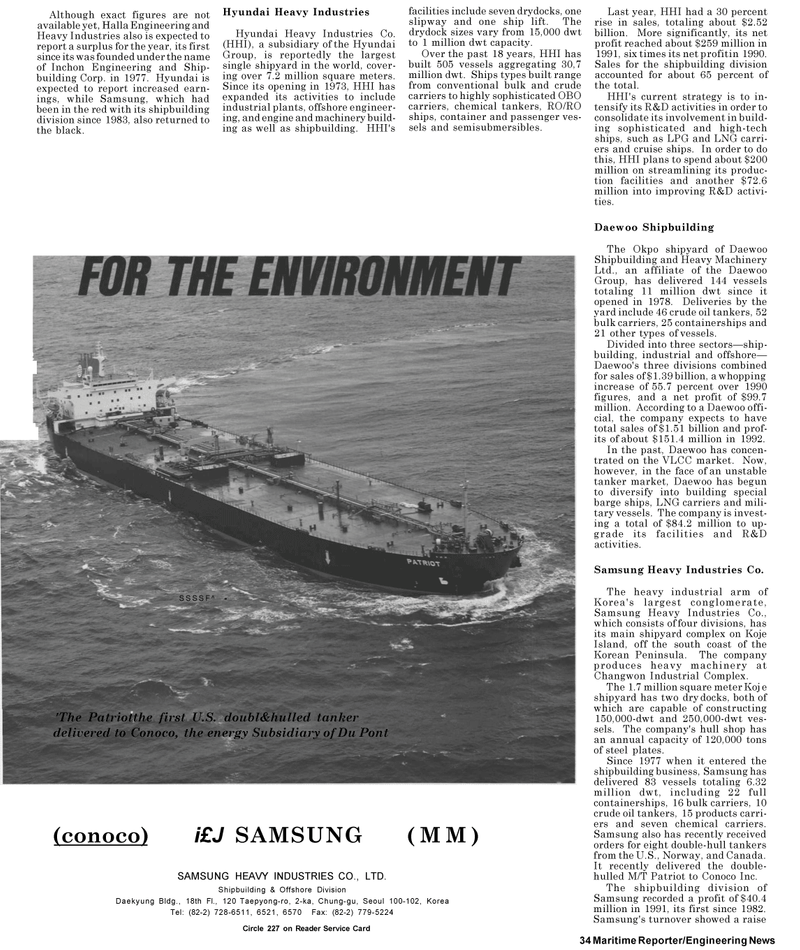
Page 32: of Maritime Reporter Magazine (May 1992)
Read this page in Pdf, Flash or Html5 edition of May 1992 Maritime Reporter Magazine
... .
SSSSF^ - 'The Patriotthe first U.S. doubl&hulled tanker delivered to Conoco, the energy Subsidiary of Du Pont (conoco) i£J SAMSUNG (MM)
SAMSUNG HEAVY INDUSTRIES CO., LTD.
Shipbuilding & Offshore Division
Daekyung Bldg., 18th Fl., 120 Taepyong-ro, 2-ka, Chung-gu, Seoul 100-102, Korea
Tel: (82-2) 728-6511, 6521, 6570 Fax: (82-2) 779-5224
Circle 227 on Reader Service Card
Samsung Heavy Industries Co.
The heavy industrial arm of
Korea's largest conglomerate,
Samsung Heavy Industries Co., which consists of four divisions, has its main shipyard complex on Koje
Island, off the south coast of the
Korean Peninsula. The company produces heavy machinery at
Changwon Industrial Complex.
The 1.7 million square meter Koj e shipyard has two dry docks, both of which are capable of constructing 150,000-dwt and 250,000-dwt ves- sels. The company's hull shop has an annual capacity of 120,000 tons of steel plates.
Since 1977 when it entered the shipbuilding business, Samsung has delivered 83 vessels totaling 6.32 million dwt, including 22 full containerships, 16 bulk carriers, 10 crude oil tankers, 15 products carri- ers and seven chemical carriers.
Samsung also has recently received orders for eight double-hull tankers from the U.S., Norway, and Canada.
It recently delivered the double- hulled M/T Patriot to Conoco Inc.
The shipbuilding division of
Samsung recorded a profit of $40.4 million in 1991, its first since 1982.
Samsung's turnover showed a raise 34 Maritime Reporter/Engineering News
Last year, HHI had a 30 percent rise in sales, totaling about $2.52 billion. More significantly, its net profit reached about $259 million in 1991, six times its net profitin 1990.
Sales for the shipbuilding division accounted for about 65 percent of the total.
HHI's current strategy is to in- tensify its R&D activities in order to consolidate its involvement in build- ing sophisticated and high-tech ships, such as LPG and LNG carri- ers and cruise ships. In order to do this, HHI plans to spend about $200 million on streamlining its produc- tion facilities and another $72.6 million into improving R&D activi- ties.
Daewoo Shipbuilding
The Okpo shipyard of Daewoo
Shipbuilding and Heavy Machinery
Ltd., an affiliate of the Daewoo
Group, has delivered 144 vessels totaling 11 million dwt since it opened in 1978. Deliveries by the yard include 46 crude oil tankers, 52 bulk carriers, 25 containerships and 21 other types of vessels.
Divided into three sectors—ship- building, industrial and offshore—
Daewoo's three divisions combined for sales of $1.39 billion, a whopping increase of 55.7 percent over 1990 figures, and a net profit of $99.7 million. According to a Daewoo offi- cial, the company expects to have total sales of $1.51 billion and prof- its of about $151.4 million in 1992.
In the past, Daewoo has concen- trated on the VLCC market. Now, however, in the face of an unstable tanker market, Daewoo has begun to diversify into building special barge ships, LNG carriers and mili- tary vessels. The company is invest- ing a total of $84.2 million to up- grade its facilities and R&D activities.
Although exact figures are not available yet, Halla Engineering and
Heavy Industries also is expected to report a surplus for the year, its first since its was founded under the name of Inchon Engineering and Ship- building Corp. in 1977. Hyundai is expected to report increased earn- ings, while Samsung, which had been in the red with its shipbuilding division since 1983, also returned to the black.
Hyundai Heavy Industries
Hyundai Heavy Industries Co. (HHI), a subsidiary of the Hyundai
Group, is reportedly the largest single shipyard in the world, cover- ing over 7.2 million square meters.
Since its opening in 1973, HHI has expanded its activities to include industrial plants, offshore engineer- ing, and engine and machinery build- ing as well as shipbuilding. HHI's facilities include seven drydocks, one slipway and one ship lift. The drydock sizes vary from 15,000 dwt to 1 million dwt capacity.
Over the past 18 years, HHI has built 505 vessels aggregating 30,7 million dwt. Ships types built range from conventional bulk and crude carriers to highly sophisticated OBO carriers, chemical tankers, RO/RO ships, container and passenger ves- sels and semisubmersibles.

 31
31

 33
33
